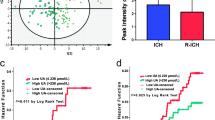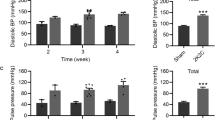Abstract
Plasma kallikrein (PKa) has been implicated in contributing to hemorrhage following thrombolytic therapy; however, its role in spontaneous intracerebral hemorrhage is currently not available. This report investigates the role of PKa on hemorrhage and hypertension in stroke-prone spontaneously hypertensive rats (SHRSP). SHRSP were fed with a high salt–containing stroke-prone diet to increase blood pressure and induce intracerebral hemorrhage. The roles of PKa on blood pressure, hemorrhage, and survival in SHRSP were examined in rats receiving a PKa inhibitor or plasma prekallikrein antisense oligonucleotide (PK ASO) compared with rats receiving control ASO. Effects on PKa on the proteolytic cleavage of atrial natriuretic peptide (ANP) were analyzed by tandem mass spectrometry. We show that SHRSP on high-salt diet displayed increased levels of PKa activity compared with control rats. Cleaved kininogen was increased in plasma during stroke compared to SHRSP without stroke. Systemic administration of a PKa inhibitor or PK ASO to SHRSP reduced hemorrhage and blood pressure, and improved neurological function and survival compared with SHRSP receiving control ASO. Since PKa inhibition was associated with reduced blood pressure in hypertensive rats, we investigated the effects of PKa on the cleavage of ANP. Incubation of PKa with ANP resulted in the generation fragment ANP5-28, which displayed reduced effects on blood pressure lowering compared with full length ANP. PKa contributes to increased blood pressure in SHRSP, which is associated with hemorrhage and reduced survival. PKa-mediated cleavage of ANP reduces its blood pressure lowering effects and thereby may contribute to hypertension-induced intracerebral hemorrhage.






Similar content being viewed by others
Data Availability
The data that support the findings of this study are available from the corresponding author upon reasonable request.
References
Brott T, Thalinger K, Hertzberg V. Hypertension as a risk factor for spontaneous intracerebral hemorrhage. Stroke. 1986;17:1078–83.
Kazui SMK, Sawada T, Yamaguchi T. Predisposing factors to enlargement of spontaneous intracerebral hemorrhage. Stroke. 1997;28:2370–5.
Qureshi AI, Mendelow AD, Hanley DF. Prevalence of elevated blood pressure in 563,704 adult patients with stroke presenting to the ED in the United States. Am J Emerg Med. 2007;25:32–8.
Carlberg B, Asplund K, Hagg E. Factors influencing admission blood pressure levels in patients with acute stroke. Stroke. 1991;22:527–30.
Sato S, Carcel C, Anderson CS. Blood pressure management after intracerebral hemorrhage. Curr Treat Options Neurol. 2015;17:49.
Willmot N, Leonardi-Bee J, Bath PMW. High blood pressure in acute stroke and subsequent outcome: a systematic review. Hypertension. 2004;43:18–24.
Lawes CMM, Bennett DA, Feigin VL, Rodgers A. Blood pressure and stroke. Stroke. 2004;35:776–85.
Schmaier AH, McCrae KR. The plasma kallikrein-kinin system: its evolution from contact activation. J Thromb Haemost. 2007;5:2323–9.
Liu J, Gao BB, Clermont AC, Blair P, Chilcote TJ, Sinha S, et al. Hyperglycemia-induced cerebral hematoma expansion is mediated by plasma kallikrein. Nat med. 2011;17:206–10.
Simao F, Feener EP. The effects of the contact activation system on hemorrhage. Front Med. 2017;4:121.
Liu J, Clermont AC, Gao BB, Feener EP. Intraocular hemorrhage causes retinal vascular dysfunction via plasma kallikrein. Invest Ophthalmol Vis Sci. 2013;54:1086–94.
Simao F, Ustunkaya T, Clermont AC, Feener EP. Plasma kallikrein mediates brain hemorrhage and edema caused by tissue plasminogen activator therapy in mice after stroke. Blood. 2017;129:2280–90.
Revenko AS, Gao D, Crosby JR, Bhattachariee G, Zhao C, May C, et al. Selective depletion of plasma prekallikrein or coagulation factor XII inhibits thrombosis in mice without increased risk of bleeding. Blood. 2011;118:5302–11.
Phipps JA, Clermont AC, Sinha S, Chilcote TJ, Bursell SE, Feener EP. Plasma kallikrein mediates angiotensin II type 1 receptor-stimulated retinal vascular permeability. Hypertension. 2009;53:175–81.
Jaffa AA, Durazo-Arvizu R, Zheng D, Lackland DT, Srikanth S, Garvey WT, et al. Plasma prekallikrein: a risk marker for hypertension and nephropathy in type 1 diabetes. Diabetes. 2003;52:1215–21.
Ferrone JD, Bhattacharjee G, Revenko AS, Zanardi TA, Warren MS, Derosier FJ, et al. IONIS-PKKKRx a novel antisense inhibitor of prekallikrein and bradykinin production. Nucleic Acid Ther. 2019;29:82–91.
Zhang F, Guo RM, Yang M, Wen XH, Shen J. A stable focal cerebral ischemia injury model in adult mice: assessment using 7T MR imaging. AJNR Am J Neuroradiol. 2012;33:935–9.
Gao BB, Chen X, Timothy N, Aiello LP, Feener EP. Characterization of the vitreous proteome in diabetes without diabetic retinopathy and diabetes with proliferative diabetic retinopathy. J Proteome Res. 2008;7:2516–25.
Mori N, Nakao K, Kihara M, Sugawara A, Sakamoto M, Yamori Y, et al. Decreased content in left atrium and increased plasma concentration of atrial natriuretic polypeptide in spontaneously hypertensive rats (SHR) and SHR stroke-prone. Biochem Biophys Res Commun. 1986;135:74–81.
De Bold AJ. Atrial natriuretic factor: a hormone produced by heart. Science. 1985;230:767–70.
Oparil S. The elusive role of atrial natriuretic peptide in hypertension. Mayo Clin Proc. 1995;70:1015–7.
Romero M, Caniffi C, Bouchet G, Costa MA, Elesgaray R, Arranz C, et al. Chronic treatment with atrial natriuretic peptide in spontaneously hypertensive rats: beneficial renal effects and sex differences. PLoS One. 2015;10:e0120362.
Thibault G, Garcia R, Cantin M, Genest J. Atrial natriuretic factor and urinary kallikrein in the rat: antagonistic factors? Can J Physiol Pharmacol. 1984;62:645–9.
Briggs J, Marin-Grez M, Steipe B, Schubert G, Schnermann J. Inactivation of atrial natriuretic substance by kallikrein. Arm J Physiol. 1984;247:F480-484.
Li B, Tom JY, Oare D, Yen R, Fairbrother WJ, Wells JA, et al. Minimization of a polypeptide hormone. Science. 1995;270:1657–9.
Zeng J, Zhang Y, Mo J, Su Z, Huang R. Two-kidney, two clip renovascular hypertensive rats can be used as stroke-prone rats. Stroke. 1998;29:1709–14.
Arribas SM, Costa R, Salomone S, Morel N, Godfraind T, McGrath JC. Functional reduction and associated cellular rearrangement in SHRSP rat basilar arteries are affected by salt load and calcium antagonist treatment. J Cereb Blood Flow Metab. 1999;19:517–27.
Arribas SM, Gordon JF, Daly CJ, Dominiczak AF, McGrath JC. Confocal microscopic characterization of a lesion in a cerebral vessel of the stroke-prone spontaneously hypertensive rat. Stroke. 1996;27:1118–23.
Lee JM, Zhai G, Liu Q, Gonzales ER, Yin K, Yan P, et al. Vascular permeability precedes spontaneous intracerebral hemorrhage in stroke-prone spontaneously hypertensive rats. Stroke. 2007;38:3289–91.
Smeda JS, Daneshtalab N. The effects of poststroke captopril and losartan treatment on cerebral blood flow autoregulation in SHRSP with hemorrhagic stroke. J Cereb Blood Flow Metab. 2011;31:476–85.
Smeda JS. Hemorrhagic stroke development in spontaneously hypertensive rats fed a North American. Japanese-style diet Stroke. 1989;20:1212–8.
Del Bigio MR, Yan HJ, Kozlowski P, Sutherland GR, Peeling J. Serial magnetic resonance imaging of rat brain after induction of renal hypertension. Stroke. 1999;30:2440–7.
Okamoto K, Ohta Y, Chikugo T, Shiokawa H, Morita N. Chronic treatment with captopril, SQ 29,852, hydralazine and a 33% fish meal diet in malignant stroke-prone spontaneously hypertensive rats. J Hypertens. 1991;9:1105–7.
Law MR, Morris JK, Wald NJ. Use of blood pressure lowering drugs in the prevention of cardiovascular disease: meta-analysis of 147 randomised trials in the context of expectations from prospective epidemiological studies. BMJ. 2009;338:b1665.
Horning B, Kohler C, Drexler H. Role of bradykinin in mediating vascular effects of angiotensin-converting enzyme inhibitors in humans. Circulation. 1997;95:1115–8.
Campbell DJ, Krum H, Esler MD. Losartan increases bradykinin levels in hypertensive humans. Circulation. 2005;111:315–20.
Calhoun DA, Jones D, Textor S, Goff DC, Murphy TP, Toto RD, White A, Cushman WC, White W, Sica D, Ferdinand K, Giles TD, Falkner B, Carey RM. Resistant hypertension: diagnosis, evaluation, and treatment: a scientific statement from American Heart Association Professional Education Committee of the Council for High Blood Pressure Research. Circulation. 2008;117:e510–26.
Mohr JP, Marti-Vilalta JL. Lacunes. In: Barnett HJM, Mohr JP, Stein BM, Yatsu FM, editors. Stroke: pathophysiology, diagnosis, and management. 3rd ed. New York, NY: Churchill Livingstone; 1998. p. 599–622.
Schreiber S, Bueche CZ, Garz C, Braun H. Blood brain barrier breakdown as the starting point of cerebral small vessel disease? – New insights from a rat model. Exp Transl Stroke Med. 2013;5:4.
Gob E, Reymann S, Langhauser F, Schuhmann MK, Kraft P, Thielmann I, et al. Blocking of plasma kallikrein ameliorates stroke by reducing thromboinflammation. Ann Neurol. 2015;77:784–803.
Liu J, Gao BB, Feener EP. Proteomic identification of novel plasma kallikrein substrates in the astrocyte secretome. Transl Stroke Res. 2010;1:276–86.
Bailey EL, Wardlaw JM, Graham D, Dominiczak AF, Sudlow CL, Smith C. Cerebral small vessel endothelial structural changes predate hypertension in stroke-prone spontaneously hypertensive rats: a blinded, controlled immunohistochemical study of 5- to 21-week-old rats. Neuropathol Appl Neurobiol. 2011;37:711–26.
Lee JM, Zhai G, Liu Q, et al. Vascular permeability precedes spontaneous intracerebral hemorrhage in stroke-prone spontaneously hypertensive rats. Stroke. 2007;38:3289–91.
Quick S, Moss J, Rajani RM, Williams A. A vessel for change: endothelial dysfunction in cerebral small vessel disease. Trends Neusoci. 2021;44:289–305.
Rajani RM, Quick S, Ruigrok SR, Graham D, Harris SE, Verhaaren BFJ, Fornage M, Seshadri S, Atanur SS, Dominiczak AF, Smith C, Wardlaw JM, Williams A. Reversal of endothelial dysfunction reduces white matter vulnerability in cerebral small vessel disease in rats. Sci Transl Med. 2018;10:eaam9507.
Tagami M, Kubota A, Sunaga T, et al. Increased transendothelial channel transport of cerebral capillary endothelium in stroke-prone SHR. Stroke. 1993;14:591–6.
Fredriksson K, Kalimo H, Westergren I, et al. Blood-brain barrier leakage and brain edema in stroke-prone spontaneously hypertensive rats: effect of chronic sympathectomy and low protein/high salt diet. Acta Neuropathol (Berl). 1987;74:259–68.
Tomimoto H, Akiguchi I, Sunaga T, et al. Alterations of the blood-brain barrier and glial cells in white-matter lesions in cerebrovascular and Alzheimer’s disease patients. Stroke. 1996;27:2096–2074.
Da Fonseca AC, Matias D, Garcia C, Amaral R, Geraldo LH, Freitas C, Lima FR. The impact of microglia activation on blood-brain barrier in brain diseases. Front Cell Neurosci. 2014;8:362.
Takeuchi S, Nagatani K, Otani N, Nawashiro H, Sugawara T, Wada K, Mori K. Hydrogen improves neurological function through attenuation of blood-brain barrier disruption in spontaneously hypertensive stroke-prone rats. BMC Neurosci. 2015;16:22.
Yamamoto E, Tamamaki N, Nakamura T, Kataoka K, Tokutomi Y, Dong YF, Fukuda M, Matsuba S, Ogawa H, Kim-Mitsuyama S. Excess salt causes cerebral neuronal apoptosis and inflammation in stroke-prone hypertensive rats through angiotensin II-induced NADPH oxidase activation. Stroke. 2008;39:3049–56.
Marks L, Carswell HV, Peters EE, Graham DI, Patterson J, Dominiczak AF, Macrae IM. Characterization of the microglial response to cerebral ischemia in the stroke-prone spontaneously hypertensive rat. Hypertension. 2001;38:116–22.
Kato J, Kida O, Nakamura S, Sasaki A, Kodoma K, Tanaka K. Atrial natriuretic polypeptide (ANP) in the development of spontaneously hypertensive rats (SHR) and stroke-prone SHR (SHRSP). Biochem Biophys Res Commun. 1987;143:316–22.
John SWM, Krege JH, Oliver PM, Hagaman JR, Hodgin JB, Pang SC, et al. Genetic decreases in atrial natriuretic peptide and salt-sensitive hypertension. Science. 1995;267:679–81.
Steinhelper ME, Cochrane KL, Field LJ. Hypotension in transgenic mice expressing atrial natriuretic factor fusion genes. Hypertension. 1990;16:301–7.
Klinger JR, Petit RD, Curtin LA, Warburton RR, Wrenn DS, Steinhelper ME, et al. Cardiopulmonary responses to chronic hypoxia in transgenic mice that overexpress ANP. J Appl Physiol. 1993;75:198–205.
Janssen WNT, de Zeuw D, van der Hem GK, de Jong PE. Antihypertensive effect of a 5-day infusion of atrial natriuretic factor in humans. Hypertension. 1989;13:640–6.
Funding
This work was supported by the National Institute of Health Grant NS107798 (F. S.), NS077006 (E. P. F.), and DK036836 (Joslin’s DRC grant).
Author information
Authors and Affiliations
Corresponding author
Ethics declarations
Ethical Approval
Experiments were performed in accordance with the guidelines of National Institute of Health Guide for the Care and Use of Laboratory Animals and were approved by the Animal Care and Use Committee of the Joslin Diabetes Center. This article does not contain any studies with human participants performed by any of the authors.
Conflict of Interest
J. G., L. D. P., T. U., and F. S. declare no competing financial interests. A. S. R. and A. R. M. are employees of Ionis Pharmaceuticals Inc., Carlsbad, CA. A. C. C. and E. P. F. are employees of KalVista Pharmaceuticals Inc., Cambridge, MA.
Additional information
Publisher's Note
Springer Nature remains neutral with regard to jurisdictional claims in published maps and institutional affiliations.
Rights and permissions
About this article
Cite this article
Guan, J., Clermont, A.C., Pham, LD. et al. Plasma Kallikrein Contributes to Intracerebral Hemorrhage and Hypertension in Stroke-Prone Spontaneously Hypertensive Rats. Transl. Stroke Res. 13, 287–299 (2022). https://doi.org/10.1007/s12975-021-00929-x
Received:
Revised:
Accepted:
Published:
Issue Date:
DOI: https://doi.org/10.1007/s12975-021-00929-x




